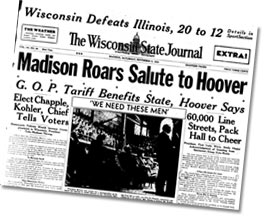A history of presidential visits to campus
Although President Obama’s campus visit on Tuesday is the first by a sitting president since May 14, 1950, campus has hosted many other sitting presidents, past presidents and candidates who would go on to win the Oval Office.
Here is a list of visits by presidents — past, sitting and future — based on a search of university archival material and the State Historical Society.
President Rutherford B. Hayes, Sept. 10, 1878: According to a 1929 Milwaukee Journal story, Hayes is reported to have “Visited the Ladies Hall at the university and mingled in ‘a friendly manner with the young lady students.’”
Woodrow Wilson, Oct. 26, 1911: A year before being elected president, Wilson spoke at a university gymnasium at a luncheon organized by state Democrats, according to the Milwaukee Journal.
President William H. Taft, May 5-7, 1915: Two years after being defeated for re-election, Taft gave a series of speeches in the Red Gym.
President Theodore Roosevelt, May 28, 1918: Roosevelt made it to campus after leaving the Oval Office, delivering a speech in the Stock Pavilion, one of the only large venues in the Madison area at the time. He was supposed to be on campus on April 3, 1903, but ended up just speaking at the state Capitol during that visit to Madison.

Courtesy: Wisconsin Historical Society
President Herbert Hoover, Nov. 5, 1932: When Hoover spoke at the Field House on a corps of university cadet officers lined Capitol Square to welcome him, and about 60,000 people lined the streets to see him pass by. A crowd of 12,000 attended a Field House event that was somewhat marred by the president’s tired voice and a faulty amplifier.
Despite the world economic crisis, he was not booed. However, days later, he received 31% of the vote in Wisconsin, compared with 63% for Franklin D. Roosevelt, says David Canon, UW–Madison political science professor.
“That’s pretty remarkable for a president who was really not very popular at the time and ended up getting thumped in the election three days later,” Canon says. “Having a live visit from a president would be more important in 1932 than today. Right before the age of television, that would be the only way to see a president, so that would be one way of explaining that huge crowd.”
President Harry Truman, Oct. 14, 1948: Truman visited campus during his re-election campaign, speaking to a capacity-filled Stock Pavilion.
Dwight D. Eisenhower, Oct. 28, 1949: Three years before being elected president, Eisenhower attended a meeting of the Association of American Universities while serving as president of Columbia University.
President Harry Truman, May 14, 1950: According to the State Journal, Truman visited Madison to give a “peace” address to a crowd at the UW–Madison Field House and a nationwide radio audience. “No one nation can bring about peace,” Truman told listeners at the Field House. Just weeks later on June 25, 1950, hostilities began between North and South Korea, pulling the United States into that bloody conflict.
That visit by Truman was unique in the university’s history because it was for a policy purpose rather than a partisan campaign visit, Canon notes.
John F. Kennedy, May 16, 1958: Kennedy gave a speech at the Wisconsin Union Theater and said about his visit with some UW students, “I found the students at Wisconsin alert, intelligent and uninhibited. It was a most stimulating meeting for me,” according to the Wisconsin Alumni Association.

Courtesy: Wisconsin Historical Society
Candidate John F. Kennedy, Oct. 23, 1960: During his presidential campaign, Kennedy filled the Field House for a campaign speech that touched on civil rights and social justice, economic growth and the Cold War.
Candidate Bill Clinton, Oct. 1, 1992: Clinton, joined by running mate Al Gore, paid a brief visit to campus after a large, late-afternoon rally on the Capitol Square. They did a live radio show inside the Memorial Union, then shook hands with people waiting outside to see them.
President Jimmy Carter, March 1, 1994: Thirteen years after leaving office, Carter delivered a speech at the Wisconsin Union Theater.
Candidate Barack Obama, Feb. 12, 2008: Obama packed the Kohl Center on a cold February evening, a night he also won primaries in the Potomac states. The crowd was estimated at 17,000, with several thousand more outside who were not able to enter.
President Bill Clinton, Feb. 14, 2008: Clinton, in support of Hillary Clinton’s presidential campaign, visited the Stock Pavilion, where he drew a crowd of several thousand supporters.
Tags: history
